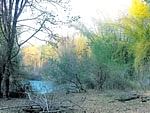
Forests across the state have a significant percentage of adivasi population dependent on natural resources for their livelihood. These diverse communities have had a symbiotic relationship in the past, but are now fragmented and few in number yet strung together culturally. The more than 50 indigenous groups who reside in the forests of Karnataka have lived in these regions for countless years.
Often, forests mean many things to many people. They are sources of food for some, trove of medicinal plants for others and valuable economic sources of timber for many.
All these are traditional demands that have been met by the forest since life began on earth. There would infact be very few forests that do not provide benefits to either man or animal, in one way or the other. This role of the forest as a mutual agent of assistance is acknowledged by millions countrywide.
Adivasis began using forest resources many centuries ago, as a result of which, their indigenous and ethno-botanical knowledge of their surroundings is immense and diversified.
Numerous instances have been documented wherein the adivasis show precise knowledge with respect to the properties of a particular plant.
Traditionally, they used to harvest species based on a time tested schedule resulting in minimal harm to the harvested species. Besides, adivasi paintings and oral tradition continually make a mention of their relations with the forest.
Traditional vaidyas (doctors) are still the mainstay for indigenous people and their services made great use of.
Need to preserve NTFP resources
This reciprocal relationship underscores the importance and need to preserve Non Timber Forest Produce (NTFP) resources.
They collect NTFPs for trade, honey being one of the major items.
Other items collected for trade are mainly resin, gooseberry, myrobalans, soapnut, eecham grass, wild pepper and nutmeg, etc. The collection is a major source of seasonal livelihood for the people.
Traditional and cultural uses of the forests are also high for most adivasi communities. Their deities live in the forests, with the ensuing protection often resulting in large tracts being nurtured as ‘sacred groves’. The rules for the use of such forests are strictly governed by the community and punishments meted out to those who violate the unwritten law.
However, the indigenous tribes of the state find themselves in a piquant position today. From the hitherto generations-old custodians of the forest to being frequently branded as the single biggest reason for resource degradation – most members of the various forest dwelling tribes wonder where are they going to end up in the coming few decades.
Material poverty
In spite of living in resource rich areas, they suffer from what can be termed material poverty.
Surrounded by relatively prosperous communities of outsiders, indigenous people feel a deep sense of apathy at their present condition and often tend to blindly follow the ways of the dominant and richer communities.
This has had an impact on their culture, food and overall lifestyle. The vicious cycle including factors like loss of tenural rights over forests, lack of food security and a high degree of dependency upon wage labour has led to a breakdown in their community governance systems and to an increase in indebtedness to money lenders.
Hemmed in by all sides, adivasis continue to languish at the lowest strata of society. Their present skills leave them ill-equipped to work in the normal structure of mainstream society and poor education levels often mean that all they end up with work as wage labourers.
It is a catch 22 situation and life has gone haywire for most members of these communities. The tenuous links with ancient forests is weakening rapidly, but they are ill at ease with the modern world.
Just as it is necessary to provide a safe refuge to diverse fauna, it is also difficult to ignore the communities who have traditionally lived by the forests and accessed it for their livelihood.
Can they be made partners in forest management and continue to protect its resources, undertaking the least damaging activity of NTFP collection, rather than large scale mutilation of forest regions? These are a few questions that beg serious discourse as involving them in forest protection is seemingly the best way ahead, as opposed to their ever-increasing dependence upon wage labour – a highly exploitative occupation.
The indigenous tribes of the state, if made modern day guardians, will result in them being the pre-eminent defenders of the forest, augmenting the efforts of the solitary forest guard, significantly.
(Kunal Sharma is a published author)